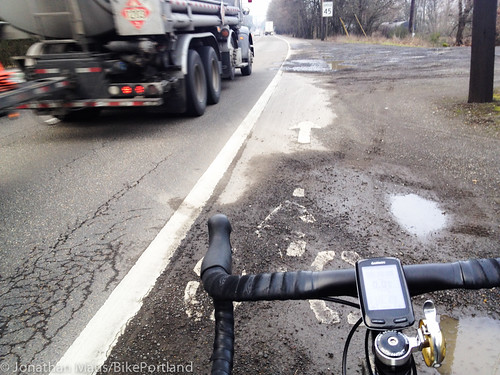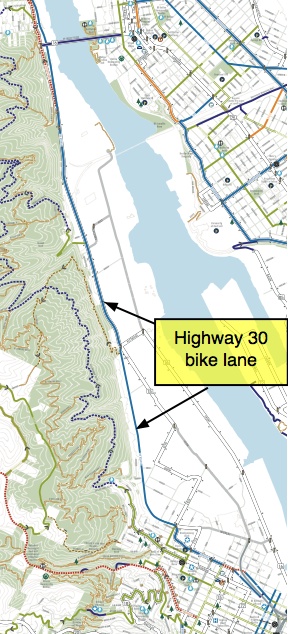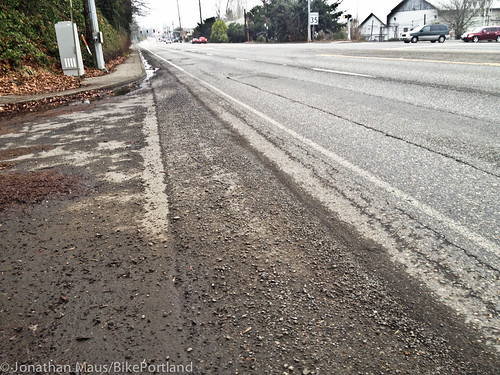
(Photos by J. Maus/BikePortland)
On the official City of Portland bike map, NW St. Helens Road/Highway 30 looks like a nice solid bike lane (see below). It’s the only north-south bike lane on the west side of the Willamette River between northwest Portland and Sauvie Island (and beyond). As such, this bike lane is an important route for many people — whether they’re commuting to St. Johns or using it as a gateway to many popular riding destinations.
Unfortunately it’s usually full of dirt, gravel, and other debris. It’s so bad that I recently learned in some circles it’s known as “Dirty 30”.
“Our street cleaning crews strive to serve all road users. That said, people using some modes of transportation experience roadway debris differently than other users.”
— Dylan Rivera, PBOT Communications Manager
When I posted some photos of this bike lane on Flickr recently, I got a comment from someone who said her experience on Highway 30 was so bad that it influenced her entire perception of Portland’s bike-ability:
“This exact “bike lane” is one of 3 or 4 main deciding factors in my decision not to move to Portland after 3 reconnaissance missions. I got so scared out of my mind on this bike lane that I ended up running up into the hills on my bad ankle to avoid having to complete my ride to Sauvie Island with huge trucks literally grazing my elbows at 55mph. I felt so trapped with no way to escape on foot or with my bike. Horrible… I found this and Barbur Blvd to be completely unforgivable of Portland and PBOT/ODOT. Utter insanity.”
Making matters worse is that it’s just a standard 5-6 foot bike lane (narrower in some spots, wider in others) and it’s adjacent to heavy auto and large truck traffic traveling at 50-plus miles an hour. In other words, you’re forced to ride directly in the debris zone or you risk being run over. As I’ve been riding this road more in recent months, I’ve been shocked at how poorly maintained it is. After I got two flats in one week (and I rarely flat), I decided to inquire with the authorities about who’s responsible for keeping it clean, why it’s so dirty, and what I can do about getting it swept.

It turns out that the Portland Bureau of Transportation and the Oregon Department of Transportation share the maintenance responsibilities. PBOT crews have jurisdiction from I-405 to Linnton (8 miles north of downtown Portland) and ODOT crews are in charge from Linnton to milepost 18.
I asked ODOT spokesman Don Hamilton about their sweeping schedule and methods. He says they sweep Highway 30 “on average… every three months or so.” The traveling public can report bad conditions directly to ODOT by calling 888-275-6368 (AskODOT hotline) or the district maintenance office at 971-673-6200. “Both are effective for registering a problem,” Hamilton says, “and both will get right on it if something more serious is going on.”
As for the City of Portland’s section, which in my experience is in much worse shape than the ODOT-controlled section, PBOT Communications Manager Dylan Rivera says they “typically sweep arterial streets four to six times per year.”
Like Hamilton, Rivera said they also respond to citizen requests and he urged folks to call 503-823-1700 to report problems.
One of the big issues on Highway 30 is that there are several long sections where the roadway has no curb and the bike lane is adjacent to gravel and dirt driveways where trucks pull out, leaving a trail of debris in their wake. In researching this article, I learned that the City of Portland has a specific policy to not sweep these “uncurbed” streets. According to the City’s website, “uncurbed streets are, in effect, self-cleaning” because motorized vehicle traffic brushes it away.
Obviously, as you can see in the photos below, curb or no curb, the “self-cleaning” is more myth than reality…
Rivera made a point to tell us that street cleaning services were cut back “significantly” during the recession” and that PBOT has had to prioritize sweeping based on citizen reports and on streets, “where the public need is the greatest.”
About the gravel-filled bike lanes on uncurbed sections of Highway 30, Rivera said they’re well aware of that issue due to one persistent citizen activist. “There is one cyclist who apparently calls every two weeks to request sweeping on Hwy 30. We have explained to him that cars and trucks pull out into the highway from unimproved parking lots along this route, spitting gravel into the bike lane over time. While we certainly try to keep the area free from debris, we do not have the resources to keep the area spotless. Other than this gentleman, we have only had 2 requests to remove debris from this area in the past 12 months.”
It seems, for now at least, people who use a bicycle to travel on Highway 30 will simply have to deal with these dangerous and dirty conditions. When I shared my perspective with Rivera that it seems people on bicycles suffer a much greater impact from the City’s current sweeping policy than people who drive a car or truck, he replied by saying, “Our street cleaning crews strive to serve all road users. That said, people using some modes of transportation experience roadway debris differently than other users.”
That’s the understatement of the year.





